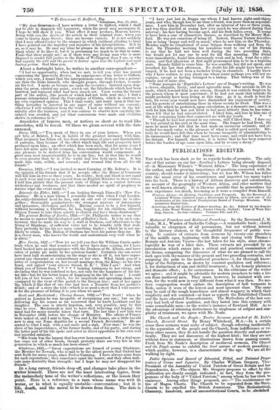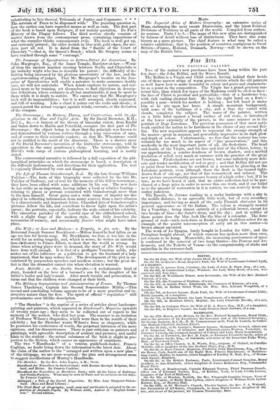PUBLICATIONS RECEIVED.
BOOKS.
THE week has been slack so far as regards books of promise. The only one of that nature on our list—Southey's Letters being already disposed of—is Missionary Wilson's "Western Africa." The long experience of the author, and the growing importance of questions connected with the country, should render it interesting; but we fear Mr. Wilson has fallen into the usual error of his countrymen and imported too many topics into his book. There is a history of African discovery and colonization, an account of the geography of Western Africa, and other matters that are well known already. It is likewise possible that he generalizes his own experience too much, becoming as it were a compiler from himself.
Western Africa : its History, Condition, and Prospects. By the Reverend J.
Leighton Wilson, eighteen years a Missionary in Africa, and now one of the Secretaries of the American Presbyterian Board of Foreign Missions. With numerous Engravings.
Selections from the Letters of Robert Southey, &e. &c. Edited by his Sou-i/1 law, John Wood Warier, B.D., Christ Church, Oxford ; Vicar of West Ter- ring, Sussex. In four volumes. Volumes III. and IV.
Medieval Preachers and Medieval Preaching. By the Reverend J. M. Neale, M.A., Warden of Saekville College.—A remarkable book ; chiefly valuable to clergymen of all persuasions, but not without interest -to the literary student, or the thoughtful frequenter of public wor- ship. It consists of extracts from sermons by twenty-one Preachers of the middle ages, beginning with Bede and closing with Thomas a Kemple and Antonio Vieyra—the last taken for his style, since chrono- logically he was of a later date. These extracts are preceded by an introduction which enters into a critical and practical examination of the theme, comparing the discourses of what we are pleased to call the dark ages with the manner of the present and two preceding centuries and assigning the palm to the mediteval preachers-1, for thorough know- ledge of the Scriptures, as shown by constant quotation and reference ; 2, for distinctness of aim and skilful treatment ; 3, for homely plainness and dramatic effect ; 4, for earnestness. In the criticisms of the writer we agree ; and it might be advisable for modern preachers to take a les- son from medheval men. They must, however, be imitated with cau- tion, for the world now is very different from what it was then. No mo- dem congregation would endure the description of hell torments in Bede, unless it were of the lowest and most ignorant class. The same may be said of the rough homeliness and almost waggery in which their simplicity and wit consisted—at least as regards the Established Church and the more educated Nonconformists. The Methodists of the last cen- tury had both of these qualities, and they lasted into this century with some remarkable men—as the writer's instance of Rowland Hill. As to the advantage of attaining distinctness by singleness of subject and sim- plicity of treatment, we agree with Mr. Neale.
The Church and the People : Twelve Sermons preached at St. Luke's Church, Berwick Street. By Henry Whitehead, M.A.—In a certain sense these sermons want unity of subject: though referring incidentally to the separation of the people and the Church, from indifference or va- rious other muses, they do not handle the question directly and systema- tically. They are not discourses of the highest kind ; but they are not, without form in statement, or illustrations drawn from passing events. Fresh from Mr. Neale's description of mediieval sermons, The Church and the People seems to exhibit the level nature of modern preaching ; which quality, however, is a characteristic of the age. We are all for walking by sight.
Public Opinion and Record of Educated, Titled, and Talented Perpe- trators of Crime and Injustice. By Charles William Gregory, Vice- President of the Assembly of United Patriots of Great Britain and her -Dependencies, &c.—The objects Mr. Gregory proposes to effect by this publication are clearly enough indicated ; in fact, they form the pro- gramme of the body of" United Patriots," among -whom he has risen 'to eminence. Among other things proposed, are,-- The maintenance en- tire of Magna -Charts. The Church to be separated from the State. Jesuits to be expelled the British dominions. The Ecclesiastical, -Chancery, Insolvent, and all imoonstitutional Courts, to be . abolished
substituting'in lieu thereof, Tribunals of Justice and Commerce. * • * The services of Peers to be dispensed with." The puzzling question is, how the author can have regarded means as well as ends. The first part • of the book is based upon Scripture, if not mainly quotation. De Foe's _History of the Plagae follows. The third section chiefly consists of matter drawn from the contemporary press, containing expositions of what-the compiler thinks contemporary evils. The book is well got up, and curiously printed; the older section in blue with gold edges, the mo- dern part all red. It is dated from the " Bastile of the Court of • Chancery "—that is, the Queen's Bench ; which Mr. Gregory seems to have reached through some "contempt."
The Language of Specifications or Letters-Patent for Inventions. By 'John Macgregor, Esq., of the Inner Temple, Barrister-at-law.—Worse oft than the ancient mariner steering between Scylla and Charybdis is the unlucky wight who has to describe his patent; the difficulty of de- finition being increased by the glorious uncertainty of the law, and the capricious ruling of judges. That Mr. Macgregor's treatise on the Lan- guage of Specifications will enable a patentee to make assurance doubly sure, we will not undertake. When minds captious by nature, and ren- dered more so by training, set themselves to find objections in descrip- tive definitions, where certainty is all but unattainable, it may be sport to
• -them while it is death to suitors. We cannot say that Mr. Macgregor's book will do impossibilities ; but it is well arranged, clearly expressed, and full of warning. Like a chart it points out the rocks and shoals ; it cannot guard the actual voyager against winds, currents, or the deviation of the compass.
The Stereoscope ; its History, Theory, and Construction, with its Ap- plication to the Fine and Usefid Arts. By Sir David Brewster, Kn., D.C.L. &c.—A history of the theory of binocular vision, from Euclid and Galen down to Harris and Poterfield, occupies the first part of Pm Stereoscope; the object being to show that the principle was known to and demonstrated by various writers through a long succession of ages, and of course to their scientific readers; so that Mr. Wheatstone could not be entitled to the merit of the discovery. There is a shorter dory of Sir David Brewster's invention of the lenticular stereoscope, told in opposition to the same gentleman's claim. The history exhibits Sir David's wide range of curious philosophical learning, and is neatly stated.
The controversial narrative is followed by a full exposition of the phi- losophical principles on which the stereoscope is based, a description of the different instruments, and directions for their application. The text is copiously illustrated by cuts and diagrams.
The Leaf Thomas Gainsborough, B.A. By the late George Williams Fuleher.—The facts of this biography were collected by the late Mr. Fulcher of Sudbury., out of zeal for the memory of his fellow-townsman ; they have been edited with some additions by his son. The new facts do not strike us as important, having rather a local or relative bearing— relating to places or persons connected with Gainsborough more than to the man himaelf. Great pains and a wide range of inquiry are dis- played in collecting information from many sources, from a mere allusion
• to a characteristic and important letter. Classified lists of Gainsborough's
• pictures follow the life, and contribute to throw light upon the artist's • career; the portraits, especially, indicate the wide extent of his celebrity. The execution partakes of the careful ease of the oldfashioned school, with a slight tinge of the modem style, that fully describes the accessories of scenery, and occasionally fancies what might have taken place.
l'he Wife; or Love and Madness : a Tragedy, in five acts. By the Reverend Joseph Sumner Brockhurst.—Milton feared he had fallen on an age too late for heroic song. Mr. Brockhurst, we fear, is too late in the world for an acting tragedy, and, which is worse he writes an introdue- -don-dedicatory to Prince Albert, to show that the world is wrong. In times when acting plays were in demand, the story of The Wife would have done well enough. It is that of a profligate Venetian noble, who makes use of his influence as a politician to get the husband of a lady imprisoned, that he may seduce her. The development of the plot is en- eumbered by purposeless speeches and needless scenes ; but the great de- fect is that the dramatist cannot rise when elevation is wanted.
Jessie hfelville; or the Double Sacrifice.—A melodramatic kind of story, founded on the love of a baronet's son for the daughter of his father's butler and lady's-maid. After much trouble and persecution, it -turns out that the children were changed at their birth.
The Military Organization and Administration of France. By Thomas James Thackemy, Captain late Second Somersetahire Militia.—This second-and concluding volume appears to be of a more practical and in- structive nature than the first. The spirit of official " regulation " still predominates over lifelike description.
"The Sketcher" is the reprint of a series of articles about landscape- painting and painters, which appeared in Blackwood's Magazine upwards of twenty years ago ; t/iey seem to be collected out of regard to the memory of the author, who died last year. The manner is an imitation of Professor Wilson's rhapsodies, which were then in the zenith of their celebrity ; but the .Sketcher wants Wilson's force or eloquence while lie possesses his exuberance of words, the perpetual intrusion of his mere .epinions, and his discursiveness. There is just criticism on painters and paintings, with agreeable description of scenery and pictures, and useful -hints to the student : the actual substance of the book is slight in pro- portion to the diction which causes an appearance of emptiness.
The two " Handbooks of a veteran guidebook-maker, Francis Coghlan, no doubt bring down the informationto the latest date. About the claim of the author to the "arranged and written upon a new plan" of the titlepage, we are more sceptical : the plan and arrangement seem 'to suggest recollections of Murray's Handbooks.
• The Sketcher. By the Rev. John Eagles, A.M., Oxon.
• Itandbook for Travellers in Switzerland; with Routes through Belgium, Hol- land, and Rhine. By Francis Coghlan.
• Handbook for Travellers in Northern Italy ; with all the Lines of Railways and Steam-Packets. What may be seen in Paris and its environs in ten days. By Francis Coghlan.
Adonijah : a Tale of the Jewish Dispersion. By Miss Jane Margaret Strick- land. (Run and Read Library.) The First Book of Geography, made env and particularly adapted la the ca- pacities of Juvenile Pupils. By William Attila, Author of "English Gram- mar." Second edition.
Mars.
The Imperial Atlas of Modern Geography : an extensive series of Maps, embracing the most recent Discoveries, and the latest Political Divisions of Territory in all parts of the world. Compiled from authen- tic sources. Parts 1 to 5.—The maps of this new atlas are distinguished by fulness of detail without loss of distinctness. They have also some beauty as a mere picture. The chief feature is what may be called a relative exhibition; that is, the position of countries contiguous to Great Britain—France, Holland, Denmark, Norway—will be shown on the map of the British Isles.



























 Previous page
Previous page